Paris Travel Guide
One of the top tourist destinations in the world, the city of Paris is glamorous, romantic, playful and crammed with fascinating places, great restaurants and beautiful things.
Paris should be at the top of the list for anyone contemplating a European holiday. The city embodies style and charm and offers a variety of unique attractions, both ancient and modern. Paris brings out the romance in every soul. Art lovers, fashionistas and foodies are particularly well catered for, while sightseers can indulge in world-famous attractions such as the Eiffel Tower and Notre-Dame. Every few steps, visitors will find something to point at or photograph in this busy bustling metro. Of course, Paris also has a thrilling nightlife and the shopping is some of the best in the world.
Paris is also a great city to visit for those travelling with children. Families can relish the fantastic delights of Disneyland Paris and amusement parks such as Parc Asterix, which are within easy reach of the city. Kids will also enjoy the many parks, forests and gardens within Paris.
Best time to visit Paris
Peak tourist season in Paris is in the summer months, between June and August, but every season has something to offer visitors. Paris is notorious for its sudden rain showers, which can occur in summer or winter. However, it is always possible to retreat indoors to explore the wonderful museums and galleries before emerging into the sunshine again to enjoy coffee and pastries at a pavement cafe. Many locals escape Paris in August when the heat can be oppressive and some restaurants close.
What to see in Paris
-Wander through the awe-inspiring galleries of The Louvre.
-See the tomb of Napoleon Bonaparte under the dome of Les Invalides.
-Visit the Pompidou Centre, the city's most popular attraction.
-Explore the magnificent palace of Versailles just outside of Paris.
What to do in Paris
-Stroll through the Jardin des Plantes and discover the many attractions of Paris's main botanical garden.
-Take an excursion to the palace of Fontainebleau.
-Marvel at the art in the incomparable Musee d'Orsay.
-Splash with the kids at Aquaboulevard on a hot day.
Beyond Paris
Paris is the perfect doorway to a number of regions of France. The Loire Valley is known as the 'Garden of France', with its many chateaux and gardens. Normandy is the military history enthusiast's dream destination. Champagne Country caters for lovers of France's famous bubbly. Paris is easily accommodated on any travel itinerary of France, not least of all because it is easy to get flights into the city.
Getting there
Paris has two world-class international airports: Charles de Gaulle Airport (also called Paris Roissy Airport), located 14 miles (23km) northeast of Paris; and Paris-Orly Airport, located nine miles (14km) south of Paris. There are direct flights to Paris from various cities in the UK, New York and many European cities.
Did you know?
-Paris has been nicknamed the 'City of Lights', but lights originally referred to the number of intellectuals who live in the city.
-Jim Morrison and Oscar Wilde are both buried at the Pere Lachaise cemetery in Paris.
-The Eiffel Tower was originally intended to be a temporary monument that would eventually be dismantled and sold as scrap.
Things to do in Paris
The Eurostar connection from London has made Paris more popular than ever as a convenient weekend destination. Paris is fairly compact and easy to navigate and many tourists opt to walk or bicycle around to soak up the flavour of the city and take in the numerous iconic landmarks and parks, or to stop at one of the many pavement cafes. A cruise down the Seine is also a popular option as many of the city's greatest sights are on the river, including Notre-Dame, the Louvre, the Place de la Concorde and the Eiffel Tower.
Other things to see in Paris include the Basilique du Sacre-Cœur, which offers great views over Paris. The Pompidou Centre houses the Musée National d'Art Modern, while the square to the west of the building attracts a varied assortment of street performers. Visitors can stroll around the cobblestone streets of the Marais district with its mansions and museums, or visit the courtyards and antique shops of Ile St-Louis, which also boasts the former homes of Marie Curie, Baudelaire and Voltaire.
South of the river, the Musée d'Orsay, the Rodin Museum and the Hotel des Invalides (the burial place of many great French soldiers, including Napoleon Bonaparte) can be found. When they've finished sightseeing, visitors can while away an afternoon in the Jardin du Luxembourg. Further along, visitors can stroll through the Jardin des Plantes, Paris' first public garden, or visit the National History Museum. The St-Germain-des-Pres neighbourhood, the former residence of existentialists Sartre and Camus, has retained much of its bohemian atmosphere with bookshops, art galleries and coffeehouses.
For free or discounted admission to many attractions in Paris, and the chance to bypass the queues, visitors can buy the Paris Museum Pass at many tourist offices, museums or metro stations.
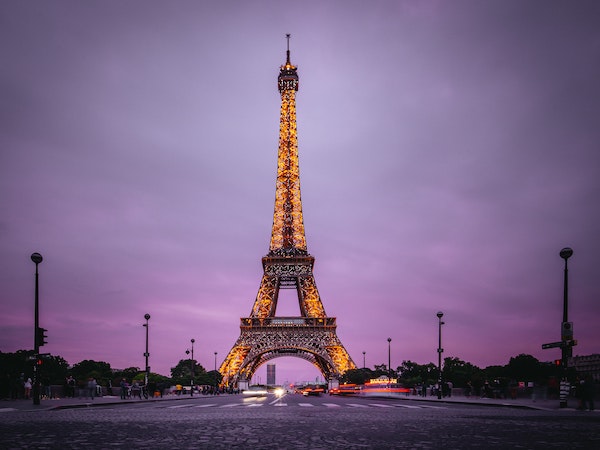
Eiffel Tower
Gustave Eiffel, the architect of the Eiffel Tower (Tour Eiffel) could never have guessed that it would become Paris' signature sightseeing attraction and attract more than six million visitors a year. It was built as a temporary structure to commemorate the centenary of the French Revolution and was opened by the Prince of Wales, later King Edward VII of England. The Eiffel Tower was considered an eyesore by many and there were petitions to have it pulled down. It was saved only because it had become an important antenna for telegraphy. It towers 984 feet (300m) above the Champ de Mars and until 1930 was the world's tallest building. The highest of its three levels offers a wonderful panoramic view over Paris.
The Eiffel Tower itself has several restaurants, including the popular Le Jules Verne, with panoramic views of the city, and a champagne bar at the very top. There are also several souvenir shops and a carousel at the base. This is a great way to keep children entertained if you plan to go to the top of the Tower, as the queues can be several hours long. A slightly different (and cheaper) way to enjoy the Eiffel Tower is with a picnic on the lawns with the famous structure providing a picturesque backdrop.
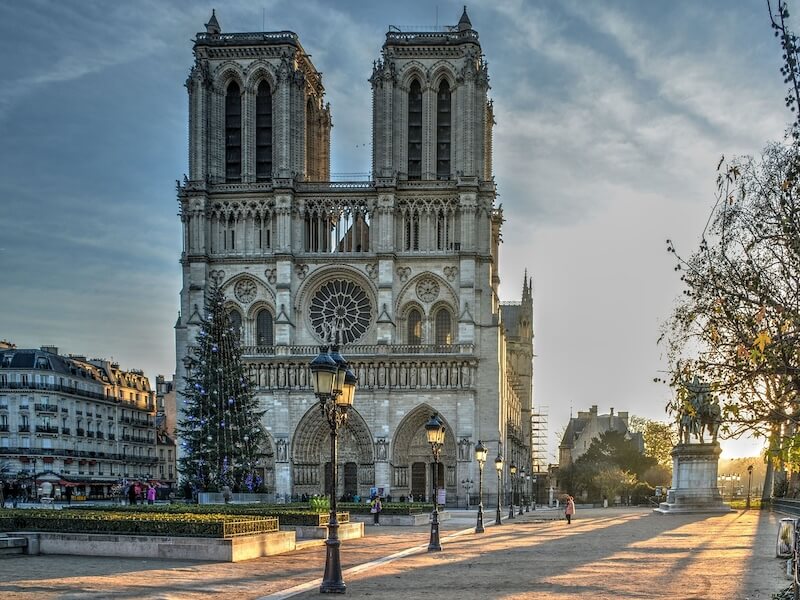
Notre-Dame
Notre-Dame looms large over the Place de Paris, on the Isle de la Cité, and as the most enduring symbol of Paris is an alluring tourist attraction. Built between 1163 and 1345 the cathedral is considered one of the world's Gothic masterpieces. The massive interior can seat 6,000 people and it is dominated by three spectacular and enormous rose windows and a vast 7,800-pipe organ. The 387-step climb to the top of the towers is worth the effort for the panoramic view of the city and the close-up views of the famous gargoyles. The tower also holds the great bell that was rung by Quasimodo, the fictional hunchback in the novel by Victor Hugo.
Opposite the north door is a museum that displays the cathedral's history, while under the square in front of the cathedral is the crypt that houses Notre-Dame's archaeological museum. The church has no real gift shop, but votive candles are available at points in the cathedral in return for a donation.
For a special experience, visit Notre-Dame on a Sunday morning when many of Paris's museums are closed and services are being held, but be respectful of worshippers, especially when taking photos. Another really special time to visit Notre Dame is on summer evenings for the Night Show, an operatic performance projected on a 100-metre tulle screen hanging in the nave. The performances are held nightly in July and August.
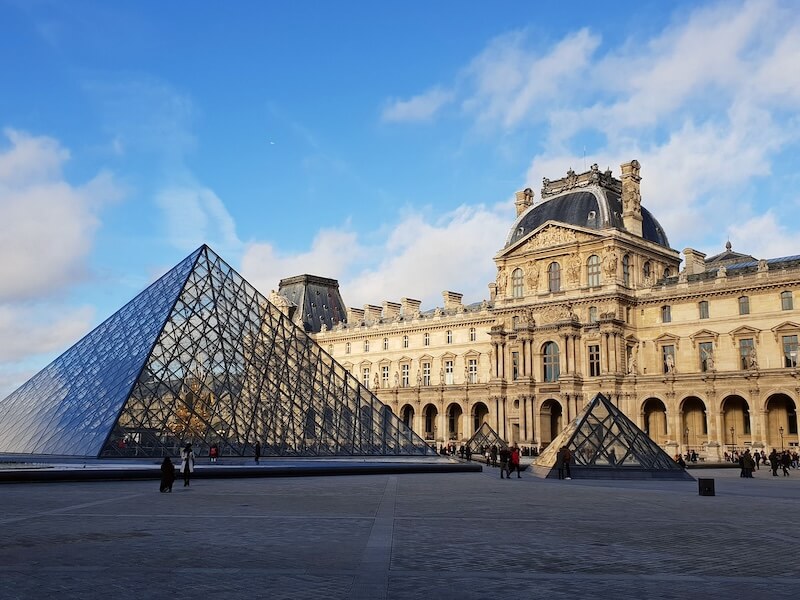
Louvre
One of the world's great art museums, this vast edifice houses an extraordinary collection of paintings, sculptures and antiquities from all over the world. The permanent collections are divided into Egyptian, Greek, Roman and Asian antiquities, painting, drawings, sculptures and objects d'art.
The Louvre was opened to the public in 1793, soon after the Revolution, to display the spectacular treasures looted from the royal palaces. The best-known attractions in the Louvre are Leonardo da Vinci's enigmatic Mona Lisa, which is protected by bullet-proof glass within its own room; and the ancient Venus de Milo. While the Venus de Milo is one of the highlights of a visit to the Louvre, the Mona Lisa can be a disappointment because people usually imagine it is much bigger than it is, and it is usually surrounded by a crowd. With more than 35,000 works on display, don't even attempt to see it all in one day. The building itself is a work of art and the ceilings, floors and staircases will enthral visitors.
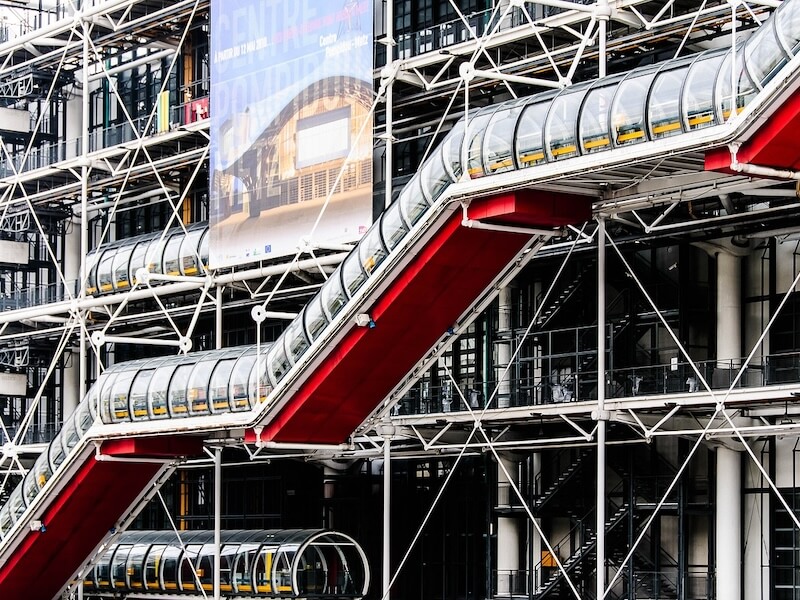
Pompidou Centre
Built in the 1970s and named after former French president Georges Pompidou, the futuristic Pompidou Centre is now considered part of the Parisian landscape. The outrageous design, complete with its glass elevators, was the inspiration for the Lloyds Building in London and attracts visitors by the million; it is the city's most popular attraction by far. The building houses the Musée National d'Art Modern (MNAM), which displays a vast collection of 20th-century art, from Fauvism and Cubism to Abstract and Absurd, and its numerous cinemas and theatres have regular musical and dance performances. The square to the west of the building attracts a varied assortment of street performers. While there, visitors should be sure to check out the whimsical Stravinsky Fountain with its 16 water-spraying sculptures.
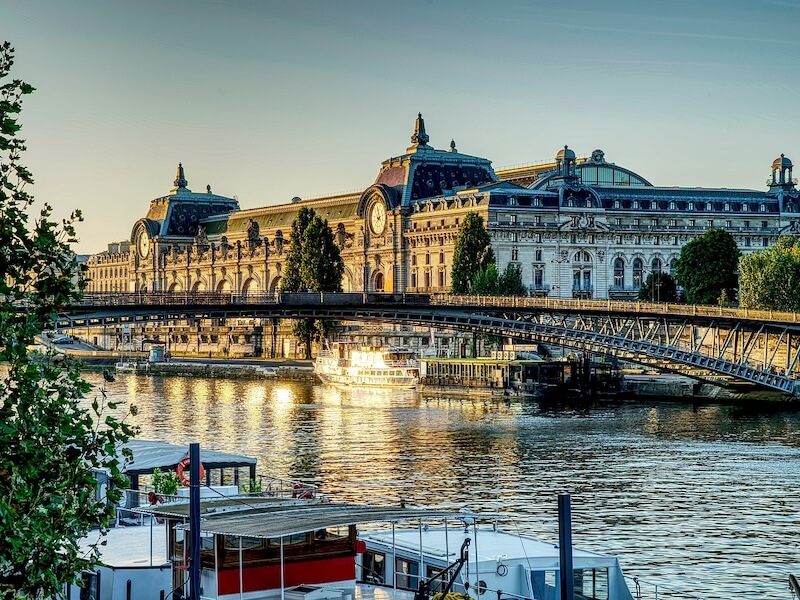
Musée d'Orsay
This great museum is fairly new by Paris standards. It is situated in a railway station by the Seine and houses a vast collection of works from the significant 1848 to 1914 period. There are important works from the Art-Nouveau movement but the Orsay is best known for its Impressionist and Post-Impressionist art. The collection is arranged chronologically and contains highly regarded works by Monet, Manet and Courbet. Also on permanent display is the famous painting by Gustave Doré entitled L'enigme, and Henri Chapu's marble statue of Joan of Arc in Domremy. The Musee d'Orsay is one of the most famous art museums in the world and one of France's premier attractions. Even the uninitiated will appreciate this world-class museum, and art fanatics will be in heaven. There is a restaurant and a book shop at the museum.

Musée Rodin
The Rodin Museum is situated near the Musée d'Orsay and is housed in what was formerly the Hôtel Biron, the beautiful hotel where Auguste Rodin (1840 to 1917) once lived and worked. Inside are many of Rodin's great marble sculptures including The Kiss, while outside, in the garden, are famous bronzes including The Thinker. The museum also includes many works by Camille Claudel (Rodin's pupil and mistress) and paintings by Van Gogh, Renoir, Manet and Rodin himself. The museum has a gift shop, with reproductions of some of the most famous works.

Musée National Picasso
The Picasso Museum is situated in a 17th century mansion in the heart of Paris. The collection was started in 1973, after the French government accepted Picasso's own collection in lieu of death duties, and was added to after his widow's death in 1990. All the phases of work from the Paris-based artist are represented here including his paintings, drawings, ceramics, sculptures and even poetry. Memorable works include the self-portrait Paola as Harlequin, and Nude in an Armchair. Most of Picasso's great paintings, however, are owned by and housed in foreign museums or are in the hands of private collectors. It is an unusual museum (mainly because of the unusual artist) and a must for Picasso enthusiasts and anybody who appreciates art. The mansion that houses the museum is gorgeous and creates just the right atmosphere for the diverse collection.
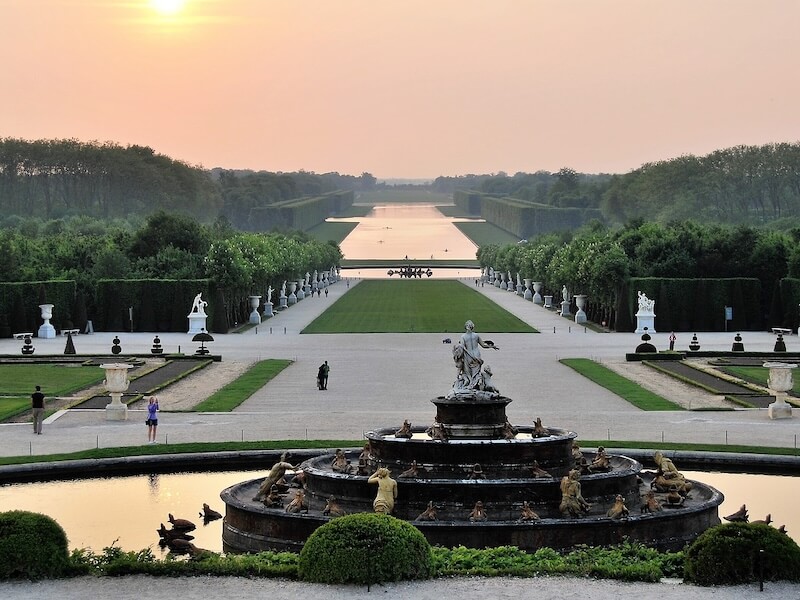
Versailles
The Château de Versailles stands 15 miles (24km) southwest of Paris and is one of France's most noted attractions. Most of the palace was built between 1664 and 1715 by Louis XIV (known as the Sun King), who turned his father's hunting lodge into the grandest palace ever built. The 'Old Château' still exists but is enveloped by the vast white stone façade of the New Château. This lavish statement of monarchical power was to become a symbol of the excess that would lead to the revolution of 1789.
Perhaps the most famous room in the palace is the Hall of Mirrors (Galerie des Glaces) where the Treaty of Versailles was signed, signifying the end of the Great War. Within the palace visitors can also see the former royal bedchambers, the grand staircase and other staterooms, and within the vast landscaped park and gardens are many wonderfully ornate fountains and ponds. There is a small train that ferries visitors from the palace to the Grand Trianon and Petit Trianon, former love nests where both the Sun King and Napoleon enjoyed the company of their mistresses.

Fontainebleau
In the 16th century, Henry II and Catherine de Medici commissioned architects Philibert Delorme and Jean Bullant to build a new palace within the Fontainebleau forest, 40 miles (64km) south of Paris. Italian Mannerist artists Rosso Fiorentino and Primaticcio came to assist in the interior decoration, helping to found the School of Fontainebleau. Visitors will see the long Gallery of François I, which the artists adorned with scenes such as The Rape of Europa and the monarch holding a pomegranate, a symbol of unity, as well as the richly adorned Louis XV Staircase and the monumental fireplace and frescoes in the ballroom.
The palace was a refuge for French monarchs from the days of the Renaissance. They valued it because of its distance from the slums of Paris and for the rich hunting grounds that surrounded it. Many important events have occurred here, perhaps none more memorable than when Napoleon stood on the grand steps in front of the palace and bade farewell to his shattered army before departing for Elba. The chateau boasts four museums, beautiful and vast grounds and many treasures. Compared to the glories of Versailles, however, Fontainebleau can be a bit of an anti-climax; it is best to see it before Versailles.
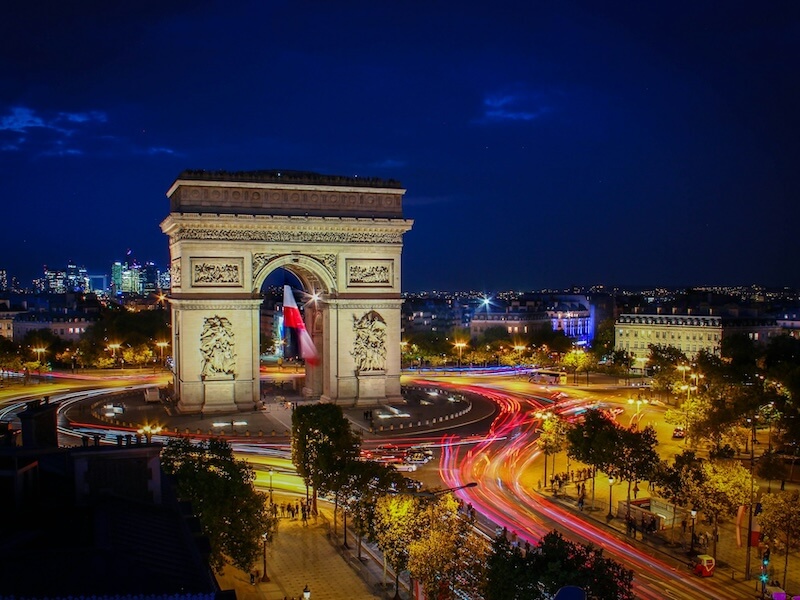
Arc de Triomphe
The world's largest triumphal arch, the Arc de Triomphe de l'Etoile is set at the centre of a star-shaped configuration of 12 radiating avenues in the heart of the Champs Elysées. It stands 165 feet (51m) tall and the names of major victories won during the Revolutionary and Napoleonic periods are engraved around the top of the Arch. The names of less important victories, as well as those of 558 generals, can be found on the inside walls.
Since 1920, the tomb of France's Unknown Soldier has been sheltered underneath the arch. Its eternal flame commemorates the dead of the two world wars, and is rekindled every evening at 6pm. On July 14, the French National Day, also known as Bastille Day, a military parade starts at the arch and proceeds down the Champs Elysées. Visitors can climb to the top of the Arc de Triomphe (or take the elevator) and the views over Paris are spectacular. It is a humbling monument that can't fail to inspire respect and awe, and a trip to Paris is not complete without a visit.
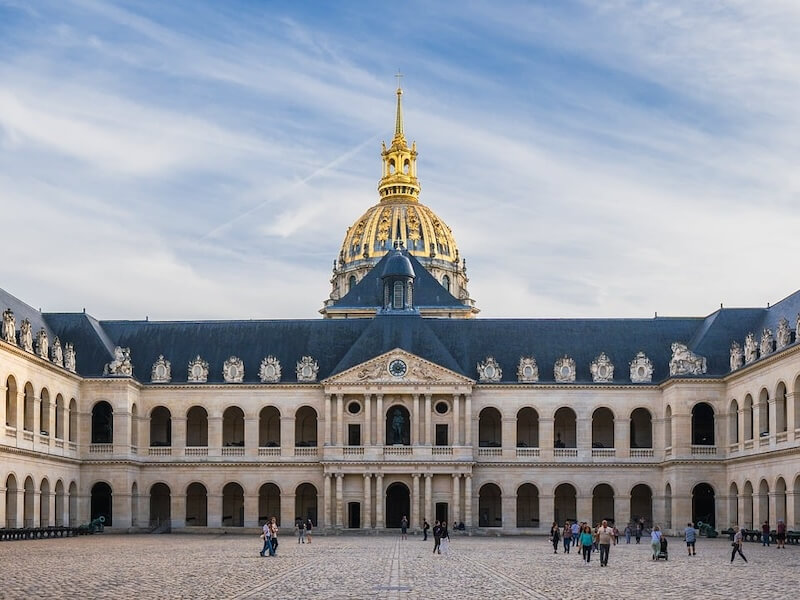
Les Invalides
Les Invalides was built by Louis XIV in 1670 as a military hospital to take care of wounded soldiers and now comprises the largest single collection of monuments and museums in Paris, all relating to the military history of France. It is the burial site of some of France's war heroes, and a number of France's famous dead, including the ashes of the greatest French military commander, Napoleon Bonaparte, which rest under the dome of Les Invalides and attract many visitors to Paris. Its large grounds and church with a golden dome make Les Invalides a classical French architectural masterpiece. There are also impressive collections of weaponry from all periods of French history. Numerous suits of armour, including those made in children's sizes for boy kings, are part of this collection. Military history buffs will be in heaven at Les Invalides and even the less clued-up will be moved by the place.

Jardin des Plantes
The Jardin des Plantes is France's main botanical garden. Covering 28 hectares (280,000sq m), the garden was originally planted by Louis XIII's doctor in 1626 as a medicinal herb garden. In 1640 it became Paris's first public garden. In 1739, after a long period of decline, the gardens were greatly expanded and a maze called the Labyrinth was added. It still exists today. Currently, in addition to being a lovely green lung in the city, the Jardin des Plantes maintains a botanical school which constructs demonstration gardens and trains botanists.
The massive grounds house the Natural History Museum which is one of the main attractions for visitors. There is also a small zoo, founded in 1795 to house part of the royal menagerie from Versailles, and now containing small animals in simulated natural habitats. The gardens boast tropical hothouses that are home to a variety of unusual plants, native mostly to Mexico and Australia, and there is also an Alpine Garden, a beautiful Rose Garden, and an Art Deco-style Winter Garden. There is lots to see in the garden and visitors can wander for hours.
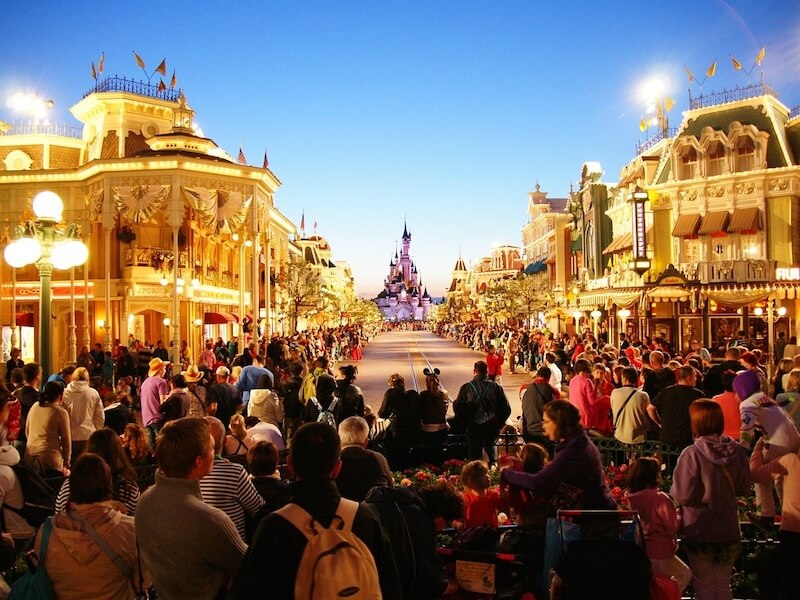
Disneyland Paris
The blueprints for the holiday destination of Disneyland may have been developed in the United States, but the world's favourite theme park concept has transported exceedingly successfully to Europe. Situated 20 miles (32km) east of Paris, Disneyland Paris (also known as EuroDisney) is a vast complex of hotels, restaurants and shops together with the exciting theme park. Those in the know have it that Europe's Disneyland is actually better than its US counterparts, boasting more modern technology and existing in the ambit of less control and different safety regulations. EuroDisney has also unavoidably picked up a European flavour which adds charm and intimacy to the entire experience.
EuroDisney actually consists of two theme parks. The Disneyland Park, based on California's iconic Magic Kingdom, boasts 53 awesome attractions, drawing thousands of holidaymakers every year. The Walt Disney Studios were built more recently and follows the trend of the Disney MGM Studios in Florida, USA, using movie-like settings for thrill rides and experiences. Adults and children alike become enchanted and enthralled as they explore fantasy neighbourhoods bristling with Disney characters, and stop to take in the spectacle of the day and night parades.
Most visitors come to EuroDisney on a package deal that includes onsite hotel accommodation and passes to enjoy the shows and attractions. At least two days are required to make the most of the Disney magic, and there will still be plenty left for a second visit.

Musée National d'Histoire Naturelle
Located in the Jardin des Plantes, the Musée National d'Histoire Naturelle (Natural History Museum) greets visitors with two gigantic whale skeletons at the entrance. With wonderful exhibitions and fascinating displays on botany, archaeology and palaeontology, the museum will captivate kids' imaginations and educate them as well. The dinosaur exhibit is hugely popular with the younger visitors, but this museum is a must for children of all ages. The museum is large and actually combines three museums into one (sometimes they are listed independently), including a four-story taxonomy wing called the Hall of Evolution, a gallery dedicated to palaeontology (the study of fossils, including the beloved dinosaur exhibit) and a separate building devoted entirely to mineralogy. Visitors can choose to visit only one of these three museums. There is plenty to enthral little ones (and grown up ones) and the fact that the museum feels a little old-fashioned actually adds to its charm.

Le Jardin d'Acclimatation
This children's amusement park attracts thousands of tourists every year. It features a menagerie and the Exploradome Museum, with fantastic optical illusions and amazing structures. The park's attractions include zip-lines, swings, deforming mirrors, paddling pools, radio-controlled boats, a theatre, a small farm, pony and camel rides, an aviary, a butterfly garden and amusement rides. Apart from being loads of fun this wonderland of games and activities is frequently educational.
The park offers workshops for children over three that aim not only to amuse but to teach skills and cultivate talents; workshops revolve around things such as cooking, gardening, magic and theatre. There are also joint workshops for parents and young children and a few classes for adults only. There are a number of restaurants and cafes on the premises for refuelling. This is a great place for kids to blow off steam at the same time as learning some useful skills, and the activities are wonderful for parent/child bonding too.

Parc Asterix
Based on the famous comics by Uderzo and Goscinny about cheeky Gauls who annoy the Roman Empire, the Parc Asterix is a theme park located just outside of Paris. Kids will love meeting their favourite characters, including, of course, Asterix himself, and his giant friend Obelix. The park is well known for its large variety of roller-coasters and has begun incorporating rides and themes from historic cultures such as the Romans and the ancient Greeks.
There are now six different worlds at the park: Gaul, Egypt, Ancient Greece, the Roman Empire, Vikings, and Travel through Time. Apart from the epic rollercoasters, popular rides include the Menhir Express, a log flume ride, the Goudurix, the Grand Splatch and the Oxygénarium. There are lots of shows at the park and entrance to these performances is included in admission tickets. One of the more popular shows is the dolphin and sea lion show. The Parc Asterix will delight children but it is also wonderful for adults and there are plenty of thrilling rides for adrenalin seekers.
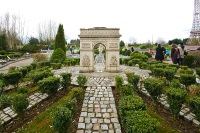
France Miniature
Located in Flancourt, France Miniature features more than 130 models of famous French attractions, such as the Eiffel Tower, Lourdes, St Tropez, Le Mont-Saint-Michel and Versailles, for visitors to enjoy. Everything has been created with a 1:30 scale and some for the models are even animated. The detail of the models is remarkable and a joy for those interested in architecture as well as kids. The miniature world includes mechanised trains, cars and boats and there are tiny people visiting the attractions. Children will love spending a day out at this miniature country which feels like a massive doll's house. There are also some fun games and a small amusement park with several rides on offer. There is a restaurant and a souvenir shop on site but a lovely way to enjoy the park, and save money, is for visitors to bring along their own picnic.
Aquaboulevard
Located in the heart of the city of Paris, Aquaboulevard is the largest water park in Europe and a great treat for kids (and adults!). One of the big advantages of this attraction is the fact that most of it is indoors, making it fun on sunny or rainy days in Paris; if visitors are travelling with kids it's a good activity to keep up their sleeve for a rainy day. The park itself includes various waterslides, a spa area with hot baths and Jacuzzis, indoor and outdoor wave pools, a beach area for relaxing, and a wave machine that allows visitors to try surfing or wakeboarding on a standing wave, among other things. The attractions are not limited to water either: the complex also offers cinemas, a mini-golf course, tennis courts, a fitness centre, play areas, and other indoor attractions. Children under three are not allowed into Aquaboulevard and proof of age should be taken for young kids.
Things to do with kids in Paris
Paris might be the most romantic city in the world but it's also well geared towards children. Parents will find there are endless activities and attractions to enjoy with their little ones.
Families can marvel at the glorious city views from the top of the Eiffel Tower, or head down the Champs Elysées for a spot of shopping, though they should beware of the tourist traps. Kids will love the miles of beach along the shores of the Seine River. Playing in the sun and splashing in the river has become a popular activity for families and children during the summer months. The Jardin des Tuileries is a great place to take the kids for a stroll and to let out some of their pent-up energy.
Paris is a haven for carousels, which can be found in various parks around the city, including the Parc du Champ de Mars, the Jardin Des Tuileries and Luxembourg Gardens.
When the weather turns bad and outdoor activities are not an option, families can visit some of the exciting museums and indoor playgrounds dotted throughout this exciting city, such as the Ludimax, a giant indoor playground situated near St Germain-en Laye and Versailles, and the Aquaboulevard indoor waterpark.
Of course, kids won't let their parents forget the proximity of the magical Disneyland Paris and there are other famous amusement parks to visit, such as the Parc Asterix and France Miniature.

Disneyland Paris
The blueprints for the holiday destination of Disneyland may have been developed in the United States, but the world's favourite theme park concept has transported exceedingly successfully to Europe. Situated 20 miles (32km) east of Paris, Disneyland Paris (also known as EuroDisney) is a vast complex of hotels, restaurants and shops together with the exciting theme park. Those in the know have it that Europe's Disneyland is actually better than its US counterparts, boasting more modern technology and existing in the ambit of less control and different safety regulations. EuroDisney has also unavoidably picked up a European flavour which adds charm and intimacy to the entire experience.
EuroDisney actually consists of two theme parks. The Disneyland Park, based on California's iconic Magic Kingdom, boasts 53 awesome attractions, drawing thousands of holidaymakers every year. The Walt Disney Studios were built more recently and follows the trend of the Disney MGM Studios in Florida, USA, using movie-like settings for thrill rides and experiences. Adults and children alike become enchanted and enthralled as they explore fantasy neighbourhoods bristling with Disney characters, and stop to take in the spectacle of the day and night parades.
Most visitors come to EuroDisney on a package deal that includes onsite hotel accommodation and passes to enjoy the shows and attractions. At least two days are required to make the most of the Disney magic, and there will still be plenty left for a second visit.

Musée National d'Histoire Naturelle
Located in the Jardin des Plantes, the Musée National d'Histoire Naturelle (Natural History Museum) greets visitors with two gigantic whale skeletons at the entrance. With wonderful exhibitions and fascinating displays on botany, archaeology and palaeontology, the museum will captivate kids' imaginations and educate them as well. The dinosaur exhibit is hugely popular with the younger visitors, but this museum is a must for children of all ages. The museum is large and actually combines three museums into one (sometimes they are listed independently), including a four-story taxonomy wing called the Hall of Evolution, a gallery dedicated to palaeontology (the study of fossils, including the beloved dinosaur exhibit) and a separate building devoted entirely to mineralogy. Visitors can choose to visit only one of these three museums. There is plenty to enthral little ones (and grown up ones) and the fact that the museum feels a little old-fashioned actually adds to its charm.

Le Jardin d'Acclimatation
This children's amusement park attracts thousands of tourists every year. It features a menagerie and the Exploradome Museum, with fantastic optical illusions and amazing structures. The park's attractions include zip-lines, swings, deforming mirrors, paddling pools, radio-controlled boats, a theatre, a small farm, pony and camel rides, an aviary, a butterfly garden and amusement rides. Apart from being loads of fun this wonderland of games and activities is frequently educational.
The park offers workshops for children over three that aim not only to amuse but to teach skills and cultivate talents; workshops revolve around things such as cooking, gardening, magic and theatre. There are also joint workshops for parents and young children and a few classes for adults only. There are a number of restaurants and cafes on the premises for refuelling. This is a great place for kids to blow off steam at the same time as learning some useful skills, and the activities are wonderful for parent/child bonding too.

Parc Asterix
Based on the famous comics by Uderzo and Goscinny about cheeky Gauls who annoy the Roman Empire, the Parc Asterix is a theme park located just outside of Paris. Kids will love meeting their favourite characters, including, of course, Asterix himself, and his giant friend Obelix. The park is well known for its large variety of roller-coasters and has begun incorporating rides and themes from historic cultures such as the Romans and the ancient Greeks.
There are now six different worlds at the park: Gaul, Egypt, Ancient Greece, the Roman Empire, Vikings, and Travel through Time. Apart from the epic rollercoasters, popular rides include the Menhir Express, a log flume ride, the Goudurix, the Grand Splatch and the Oxygénarium. There are lots of shows at the park and entrance to these performances is included in admission tickets. One of the more popular shows is the dolphin and sea lion show. The Parc Asterix will delight children but it is also wonderful for adults and there are plenty of thrilling rides for adrenalin seekers.

France Miniature
Located in Flancourt, France Miniature features more than 130 models of famous French attractions, such as the Eiffel Tower, Lourdes, St Tropez, Le Mont-Saint-Michel and Versailles, for visitors to enjoy. Everything has been created with a 1:30 scale and some for the models are even animated. The detail of the models is remarkable and a joy for those interested in architecture as well as kids. The miniature world includes mechanised trains, cars and boats and there are tiny people visiting the attractions. Children will love spending a day out at this miniature country which feels like a massive doll's house. There are also some fun games and a small amusement park with several rides on offer. There is a restaurant and a souvenir shop on site but a lovely way to enjoy the park, and save money, is for visitors to bring along their own picnic.
Aquaboulevard
Located in the heart of the city of Paris, Aquaboulevard is the largest water park in Europe and a great treat for kids (and adults!). One of the big advantages of this attraction is the fact that most of it is indoors, making it fun on sunny or rainy days in Paris; if visitors are travelling with kids it's a good activity to keep up their sleeve for a rainy day. The park itself includes various waterslides, a spa area with hot baths and Jacuzzis, indoor and outdoor wave pools, a beach area for relaxing, and a wave machine that allows visitors to try surfing or wakeboarding on a standing wave, among other things. The attractions are not limited to water either: the complex also offers cinemas, a mini-golf course, tennis courts, a fitness centre, play areas, and other indoor attractions. Children under three are not allowed into Aquaboulevard and proof of age should be taken for young kids.
Eating Out
For many travellers, Paris is synonymous with gastronomy. The French, always appreciative of the finer things in life, have a unique tradition of famous restaurants and great chefs. Anyone with a love of good food and deep pockets will find true happiness in this city. The style of cooking known as 'la Grande Cuisine' comes from Paris and it's hard to walk the streets without being tempted into every restaurant by its delectable aroma.
Paris is home to thousands of restaurants, with traditional French bistros being the best value for money for those on a budget. Cafes and dive bars are an almost obligatory stop on the way to or from work for most Parisians, where an ordinary lunch can be enjoyed at a reasonable price. Travellers can grab a newspaper, order a glass of fine French wine and observe the city passing by while soaking up the picturesque surroundings.
From classic French cooking to Nouvelle Cuisine and French regional styles (as well as many other international cuisines), there is something to satisfy every palate in Paris.
Shopping
Paris is a shopper's paradise. Jet-setters will feel at home with the famous names of the haute couture boutiques found on Rue du Faubourg Saint-Honoré, such as Dior, Chanel, Givenchy and Jean-Paul Gaultier. Trend-setting fashions can be found in Rue Etienne Marcel shops. Sadly, the Champs-Elysées is not what it used to be, with banks, fast-food chains and malls strategically placed to trap tourists. However, some good stores remain, and perfume from Guerlain Parfumerie is a classic Paris souvenir.
Galeries Lafayette is a famous French department store. The flagship store is located on Boulevard Haussmann and has been a Paris icon since its creation in 1894. Beneath the decorative Art Nouveau dome lies 65,000 square metres of floor space hosting more than 3,500 brands from around the world. The energy, architecture, layout, restaurants and views over the city have turned Galeries Lafayette into a prime tourist attraction for shoppers and browsers alike.
Les Halles is a subterranean shopping mall with more than 150 stores where bargain hunters will be able to find cheap knock-offs and other trendy clothes. Just outside the city, La Vallée Village offers designer goods at great discounts.
Bargains closer to town can be sniffed out in abundance at the three main flea markets situated around the old gates of the city. They are, however, teeming with pickpockets and shoppers should be on their guard. Les Bouquinistes, which consists of rows of bookstalls perched against the walls of the Seine River, is a great place for bookworms to browse and barter.
Those determined to buy a plastic Eiffel Tower or other kitschy souvenir, will find tourist tat plentiful along rue de Rivoli. Those looking for something a bit different to take home should visit the La Plaque Emaillées in Filles-du-Calvaire for a taste of turn-of-the-century Parisian Art Nouveau.
Parisians buy most of their food from speciality stores such as bakeries and butcheries, which stock pastries, cheeses or pâtés to die for. The open-air markets are a fantastic place to find flowers, produce and clothing. These are frequented by most of the locals. Paris also offers a wealth of window-shopping opportunities, making it the ultimate destination for the discerning consumer.
Most shops open between 9 and 10am, and close at 7 or 8pm. France levies a sales tax of between 5.5 percent and 33 percent, depending on the merchandise. There is a VAT refund scheme for non-EU visitors, but conditions apply.
Nightlife
Paris' nightlife has a reputation extending back for hundreds of years. While most tourists won't venture beyond the crowded and overpriced bars of the Champs Elysées, there are many bustling nightlife districts in Paris worth exploring.
Bastille has a mixture of noisy nightclubs and bars best suited to twenty-somethings. Oberkampf was the place to be in the 1990s, and still buzzes with hipster-filled cafes. The area around the Louvre is home to some of the most upmarket, and expensive bars in Paris, including the Ritz's Hemingway Bar in Place Vendome, a piano bar frequented by the writer in the 1940s.
Montmartre is the home of the famous Moulin Rouge cabaret, which still presents glittering extravaganzas on a nightly basis, though the price tag is a bit higher than when it started in 1889. Nearby Pigalle offers some good rock music venues. Marais also boasts a good selection of bars and cafes, with a thriving gay and lesbian scene.
There is no end to the live music possibilities in Paris. Nouveau Casino hosts a variety of bands on most nights, and La Flèche d'Or is known as an indie-rock venue. Belleville's La Java hosts an eclectic mix of artists in the venue where Edith Piaf debuted.
For a more sedate music experience, the Cité de la Musique hosts classical, jazz and traditional concerts in a network of concert halls. And, of course, Paris is an opera paradise. Travellers will find symphonies and operas at the Opéra Bastille, lighter opera at the Opéra Comique, and they might even spot the phantom of the opera at the grand Opéra Garnier, the home of the Ballet de l'Opera National de Paris.
Cafes and bars are generally open from late afternoon to 1am with some variation, and clubs don't open until 11pm on the weekends, staying open until 5 or 6am. It's not fashionable to arrive at a Paris club until well after midnight.
Getting Around
Paris has an excellent public transport system, divided into five zones radiating out from the centre; ticket prices vary according to the number of zones required. Public transport consists of buses, an underground metro, and express trains (RER). Taxis are also available. The easiest way to get around is on the metro and the subways are generally safe at all times. It is possible to transfer between the metro and the RER trains at no extra cost. The bus system is also extensive, but is slower, less frequent and best used for getting to destinations the metro does not cover. A nightbus service, Noctilien, covers the city between 1am and 5.30am. Taxis are readily available and can be hailed or caught at taxi ranks. Vélib' bicycle rentals are also popular for getting round town: travellers can pick up a bike at one of over 1,200 stations and return it at any other.
Paris Climate and Weather
Paris has a temperate oceanic climate, but the city is known for its unexpected rain showers which can occur at any time of year. Spring, from March to May, is the driest season in Paris but rainfall is distributed fairly evenly throughout the other seasons. It is best to have an umbrella with you in Paris no matter what the season, but the rain showers are usually as brief as they are sudden. Snow is rare but the city does usually get a smattering in the winter months (December to February). Summer (June to August) temperatures are mild to warm, with average highs of 77F (25C) and occasional heat waves, while winters are very chilly with temperatures hovering around freezing point.
France travel info
Electricity
The electrical current is 230 volts, 50Hz. European two-pin plugs are standard.
Language
French is the official language.
Money
The euro (EUR) is the official currency in France. Currency can be exchanged at banks, bureaux de change and some large hotels, though visitors will get a better exchange rate at the ATMs. Major credit cards are widely accepted, particularly in major tourist destinations. Foreign currency is not accepted.
Tipping
Most restaurants and hotels automatically add a 15 percent service charge so a tip is not necessary, although another two to three percent is customary if the service has been good. If service is not included then 15 percent is customary. Taxi drivers expect 10 to 15 percent of the fare, and hairdressers about 10 percent. Hotel staff generally receive about €1.50 a day and tips of about €1 are given to washroom and cloakroom attendants and museum tour guides. Tour bus drivers and guides are also tipped.
Health
No particular vaccinations or medications are required for travel to France. The prevalence of certain tick-borne infections, such as lyme disease, tularemia, tick-borne encephalitis, and rickettsial diseases, mean that travellers should take precautions against ticks if they are travelling in rural or forested areas in warm weather. French hospitals and health facilities are first class. Visitors from other EU countries are entitled to discounted medical treatment and medicines on presentation of a European Health Insurance Card (EHIC). After Brexit, the Global Health Insurance Card (GHIC) replaced the European Health Insurance Card (EHIC) for UK citizens. The GHIC allows UK citizens access to state healthcare during visits to the EU. The GHIC is not valid in Norway, Iceland, Liechtenstein or Switzerland, nor is it an alternative to travel insurance. Otherwise, doctors and hospitals often expect immediate cash payment for health services, so medical insurance is advised.
Safety
While violent crime against tourists is rare and holidays in France are generally trouble-free, visitors should be mindful that security has been heightened following a series of terrorist attacks in recent years, particularly in the transport sector. Unattended luggage left in public places will be removed or destroyed by security staff. While generally safe, visitors to France are advised to take precautions against petty theft and to ensure their personal safety. Thieves and pickpockets operate on the metro and around airports. Theft from cars is prevalent, particularly in the south, around Marseilles, and in Corsica. Tourists are advised to conceal bags and purses even when driving, and to never leave valuables unattended in the car. Bag snatching is also common, particularly on public transport and in shopping centres, and visitors should also be vigilant of luggage while loading bags into and out of hire cars at airports.
Local customs
French culture is of paramount importance to the French people. In an increasingly Americanised world they feel duty-bound to protect it, and it is appreciated if visitors can speak a few words of French. Locals do not respond well to being shouted at in English. While the food is second to none, foreigners may find the service in many restaurants sloppy. Waiters can appear rude (particularly in Paris) and take their time. This is just the way they are. Traditional games such as pétanque (similar to lawn bowling but played on gravel) are popular in village squares, but the national sports are football, rugby and cycling. Smoking in public places is not allowed and will incur heavy fines.
Doing business
Business etiquette is important in France. A smart, fashionable sense of dress is common as the nation prides itself on haut couture. Punctuality is not always observed though and the 'fashionably late' tactic may be applied. A handshake is the common form of greeting for men and women upon first introductions. Titles are important and the person is to be referred to as 'monsieur' (Mr.), 'madame' (Mrs.), or 'mademoiselle' (Ms.). Meetings usually occur over lunches, and the French are known to enjoy food. Business hours are generally 9am to 6pm, Monday to Friday.
Duty free
Travellers from non-EU countries over 17 years of age entering France can bring in the following items duty-free: 200 cigarettes, or 100 cigarillos, or 50 cigars, or 250g tobacco. Four litres of wine and 16 litres of beer and one litre of spirits over 22 percent or two litres of alcoholic beverages less than 22 percent. Other goods up to the value of €430 for air and sea travellers, and €300 for other travellers (reduced to €175 for children under 15 years of age).
Communications
The international access code for France is +33. Travellers can purchase local prepaid SIM cards for unlocked phones or use eSIMs if their cellular providers support it on their networks. Free WiFi is available in most hotels, cafes, restaurants and similar establishments.
Passport & Visa
The borderless region known as the Schengen Area includes the following countries: Austria, Belgium, Czech Republic, Denmark, Estonia, Finland, France, Germany, Greece, Hungary, Iceland, Italy, Latvia, Lithuania, Luxembourg, Malta, The Netherlands, Norway, Poland, Portugal, Slovakia, Slovenia, Spain, Sweden, and Switzerland. All these countries issue a standard Schengen visa that has a multiple entry option, and which allows the holder to travel freely within the borders of all the aforementioned countries.
Additionally, travellers must hold sufficient funds to cover their stay in France, and proof of repatriation (a return or onward ticket, and the necessary travel documentation for their next destination). Note that Schengen visas, if required, are also valid for French Guiana and French West Indies and Reunion, provided that the Schengen visa is endorsed "Also valid for French territories being in observation of the respective French territories". We recommend that passports always be valid for six months after intended period of travel.
Entry requirements
US citizens must have a passport that is valid for at least three months after their intended departure from France (and issued within the last 10 years). No visa is required for a stay of up to 90 days within a 180-day period.
UK citizens must have a passport that is valid for at least three months after their intended departure from France (and issued within the last 10 years). No visa is required for a stay of up to 90 days within a 180-day period.
Canadian citizens must have a passport that is valid for at least three months after their intended departure from France (and issued within the last 10 years). No visa is required for a stay of up to 90 days within a 180-day period.
Australian citizens must have a passport that is valid for at least three months after their intended departure from France (and issued within the last 10 years). No visa is required for a stay of up to 90 days within a 180-day period.
South African citizens must have a passport that is valid for at least three months after their intended departure from France and must obtain a valid Schengen visa prior to travel. Passports must have at least two blank pages. Entry and transit may be refused to holders of temporary passports.
Irish citizens must have a passport that is valid on arrival. No visa is required.
New Zealand citizens must have a passport that is valid for at least three months after their intended departure from France (and issued within the last 10 years). No visa is required for a stay of up to 90 days within a 180-day period.
Useful contacts
Maison de la France (Tourist Information Agency), Paris: www.france.fr/fr
112 (General emergency)


